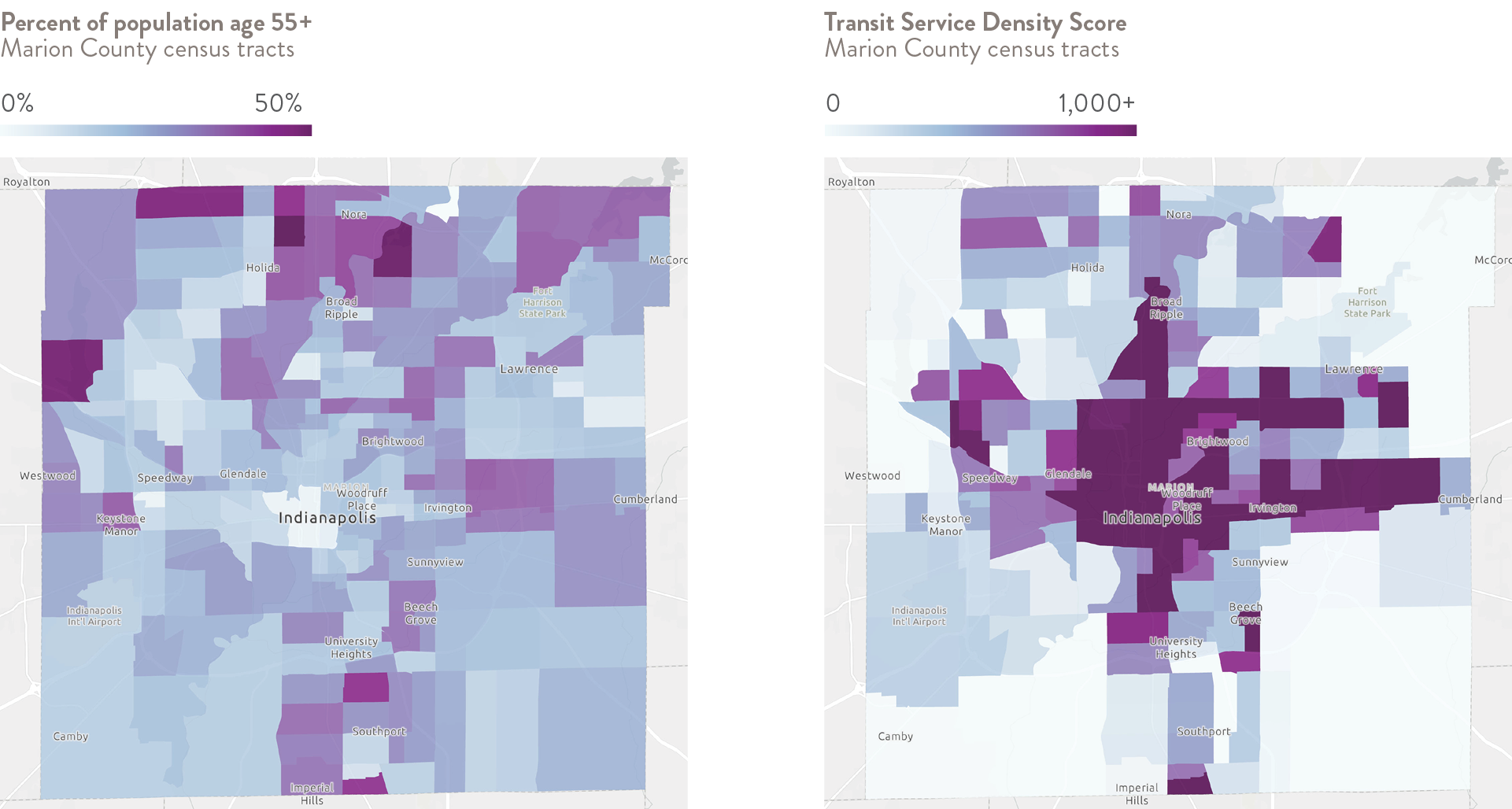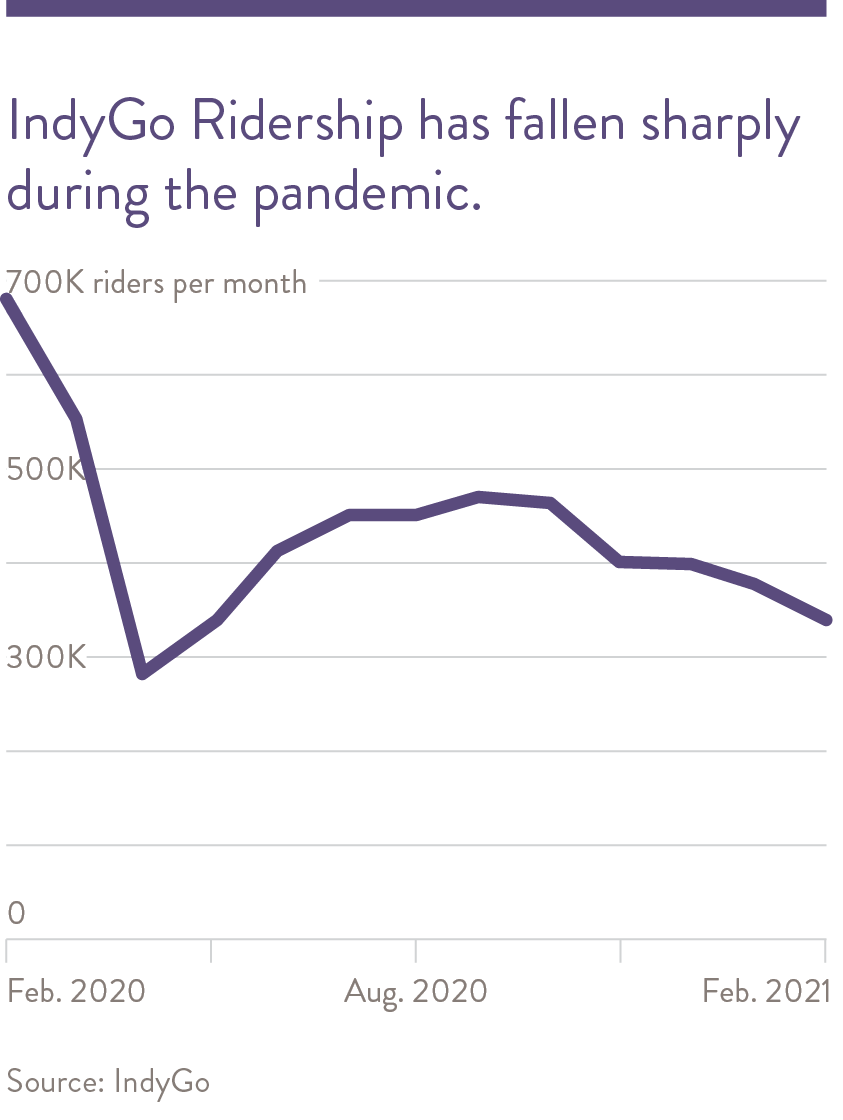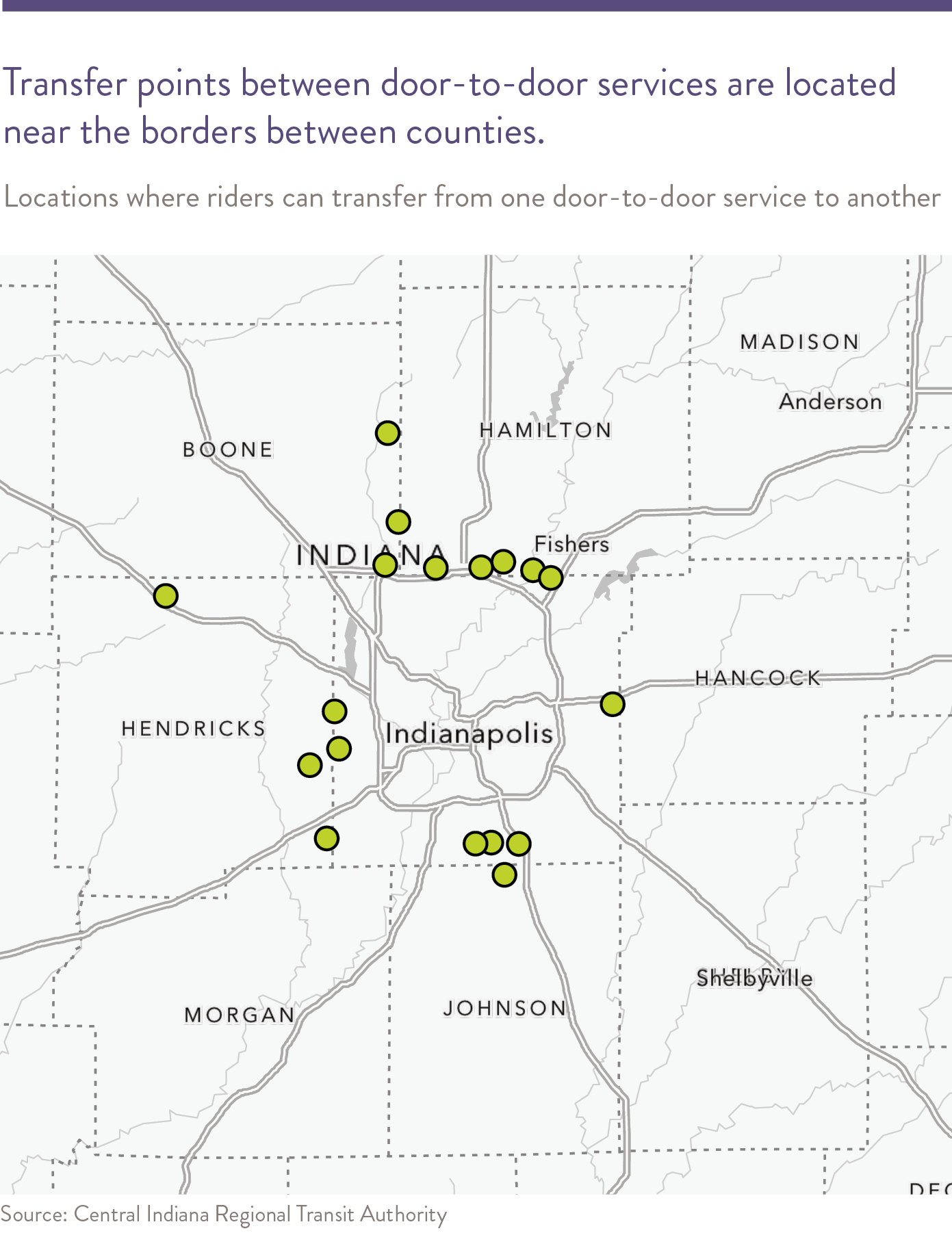Transportation 2021
Access to transportation is important because it empowers older adults to maintain their independence.Access to transportation is important because it empowers older adults to maintain their independence. Transportation opportunities for older adults may take different forms, including driving, public transportation, ride share service or shuttle buses. This section of the report discusses public transportation access and perceived transportation barriers. Key findings include:
- In Indianapolis, 7,800 older adults use public transportation for working, shopping, and social trips.
- Only one in four older adults in Central Indiana positively rates the ease with which they can use public transportation in their communities.
- In Indianapolis, one in three older adults lives in a neighborhood with minimal or no public transportation service.
- Public transportation improvements in 2019 led to 15,000 more Central Indiana older adults living in neighborhoods with high level of transportation service.
Inadequate Public Transportation
According to the U.S. Department of Transportation, “Transportation is essential to many areas of life such as employment, staying connected with family and friends, and access to healthcare.”1 However, many older adults do not have good transportation options beyond driving.
In Central Indiana, older adults find travel by car much more accessible than walking or public transportation. Three out of four older adults report that the ease of car travel is good or excellent in their communities, while only 56% say the same about walking and 25% about public transportation.2
This is an issue because the 2019 five-year American Community Survey (ACS) estimates that one in 10 households with a householder older than 65 has no vehicles in the household. Furthermore, access to vehicles varies by housing tenure with one third of householders age 65 and older living in a rental property without a vehicle in their household, versus only 4% of those living in an owner-occupied household.
Public Transportation Use by Older Adults
Indianapolis has a substantial public transportation system and in 2019, its fixed-route ridership was 9,244,855.3 Analysis of the 2017 IndyGo On-board survey data shows that one quarter of bus riders are adults age 50 and older. Some of these riders use public transportation for commuting, but others also depend on it for shopping, social visits, and other quality of life destinations. For people age 50 to 64, 46.4% of public transportation trips starting from home were for work, 11.8% were for shopping, and 28.7% were for social, religious or personal business. People age 65 and over make 21.1% of their home-based transportation trips to work, but 45.9% are for social, religious or personal purposes and 20.1% are for shopping. Medical appointments are not a common trip destination, according to IndyGo ridership data, but keeping medical appointments is important to an older adult’s health. Although only a small share (6.7%) of home-based trips had a doctor or health-related destination, the usage of IndyGo for this purpose increases with age. More than one in 10 (11.8%) older adults age 50 and over whose transportation trips started from home traveled to a doctor’s office or other health-related location.
Older public transportation riders do not use the bus as frequently as daily commuters but still take the bus at least once a week. One sixth of riders age 65 and older use public transportation one to two times per week, and over one third use it three to five times per week. Many riders age 50 to 64 use it almost daily, as 62.4% take the bus between three and seven times each week. However, these options are only available to those who live near public transportation service. Unfortunately, while some older adults live in neighborhood with good public transportation service, most do not. A transit service density score (shown in the map below) is a way of quantifying transit service available to a neighborhood. It is calculated as weekly revenue miles per square mile and ranges from zero (no transportation services) to over 1,000 (high transportation service).4
In 2019, the City of Indianapolis invested in significant public transportation improvements, which led to increased service, including for older adults who live in Marion County. Twenty more census tracts had improved service in October 2019, compared to 2018. As a result, 15,000 additional older adults now live in high public transportation service neighborhoods. Increased public transportation service broadly affects adjoining neighborhoods, not just those with high levels of service.





In 2019, the City of Indianapolis invested in significant public transportation improvements, which led to increased service, including for older adults who live in Marion County. Twenty more census tracts had improved service in October 2019, compared to 2018. As a result, 15,000 additional older adults now live in high public transportation service neighborhoods. Increased public transportation service broadly affects adjoining neighborhoods, not just those with high levels of service. Nearly 98,000 older adults now reside in census tracts where service increased 10% or more. In Marion County, the average older adult experienced a 26% improvement in service. This was accomplished by increasing the frequency and operating hours of local routes, as well as adding bus rapid transit via the newly constructed IndyGo’s Red Line. As IndyGo continues to increase local bus service and add rapid transportation lines, transportation service levels will increase further.
However, because of the COVID-19 pandemic, IndyGo experienced a decline in ridership of more than 50% between February 2020 and February 2021.5 This ridership reduction negatively impacted IndyGo’s revenue, leading to a reduction in service frequency. In turn, the reduction in service frequency impacts older adults dependent on public transportation, causing longer travel times and reducing freedom of movement to complete multiple tasks in a single trip.



Community Needs
Central Indiana households having trouble acquiring transportation have the option of dialing 2-1-1 to connect with needed services. In 2019, there were 756 calls to 2-1-1 from older adults requesting transportation assistance.6 There is a marked difference between age groups. Twice as many younger-old adults contacted 2-1-1 to obtain transportation assistance than middle-old adults. Even fewer oldest-old adults sought transportation assistance over the same time period.
The ZIP codes with the greatest number of support calls per 1,000 older adults are in Hendricks, Johnson, and Marion counties.7 This suggests that there are disparities in transportation access for older adults in these counties.
Community Perspective
According to focus group participants across Central Indiana, transportation is important for maintaining independence.8 Those who can access it enjoy the activities it allows them to do, while those who cannot felt their independence was curtailed. Across the Central Indiana region, participants report utilizing various means of transport. Some drive themselves or are driven by others, some utilize rideshare or shuttle bus programs, some who live in Indianapolis ride public transportation and others walk. The type of transportation used and the frequency with which it is used depends on affordability, accessibility and a variety of other factors. One participant drives himself and other older adults out to eat, while another who owns her own vehicle found that paying for its ongoing maintenance problems was challenging and stressful. As a part of the aging process, driving at night is no longer safe for some and lack of accessible parking is a deterrent for others when driving to locations they frequented in the past. The roundabouts in Carmel were mentioned as confusing and difficult to navigate by one participant. Other older adults relied on family or friends to drive them, which is helpful but does not always allow these older adults to be as independent as they wish.
While rideshare programs permit focus group participants to go anywhere they wish, these programs are expensive, rely on technology that some do not know how to use and are viewed as potentially unsafe by others. Shuttle bus programs, such as those through medical providers, senior centers, CICOA Aging and In-Home Solutions (CICOA) and IndyGo’s Open Door program, are options that are affordable to many participants and are useful for going to medical appointments and sometimes grocery shopping. A few participants indicated that the nominal fees charged for some of these services are not within financial reach for them, and hoped for more affordable, free options. Most of the services mentioned by older adults do not operate outside Marion County, making it difficult for older adults who must travel to the suburbs for medical, personal, or social reasons. Those transit options that do cross county lines often require reservations in advance. Depending on where they live, participants had different opinions on how accessible public transportation was. Some find it convenient, while others had difficulty accessing it. One participant mentioned how much she enjoys the new transit center downtown, while another one noted that it is difficult to navigate the stairs on the bus. Walking is also enjoyed by some as exercise or transportation; however, poor weather can make this prohibitive, particularly as ice and lack of snow clearance make sidewalks, bus stops and curbs dangerous to navigate.
Filling the Gap
The Americans with Disabilities Act (ADA) requires public transportation providers to provide paratransit to eligible individuals.9 Paratransit is a publicly-funded, low-cost ridesharing service available by request. IndyGo’s paratransit service, Open Door, operates seven days a week throughout Marion County. According to IndyGo, eligibility is based, “…on the effect the disability has on the applicant’s functional ability to board, ride and disembark independently from a fully-accessible local transit vehicle. The accessibility of the regular local transit service and the environmental and architectural barriers within the service area are also considered.”10 IndyGo conducted an evaluation of its paratransit services in 2020 and found that one in five trips are made by individuals whose start or finish location has the following characteristics: is in the outlying parts of the county, is outside the ADA required zone and has an average trip distance of 12.5 miles. This average trip distance is three miles longer than the average distance of peer paratransit agencies.11
All eight Central Indiana counties have paratransit/door-to-door service, operated by either a public transportation authority or a senior services agency. Each of these programs provides transportation within the boundaries of their respective counties. Older adults who are dependent on these services but require inter-county transportation must transfer from one county service to another at one of 19 possible transfer points across Central Indiana. Fourteen of those transfer points are between IndyGo and one of the surrounding door-to-door services.
CICOA’s Way2Go service provides scheduled rides within Marion County for a fee of $5.00 per ride. Medicaid may cover the cost of this ride service when the trip is to a medical appointment. CICOA also provides shuttle services from certain apartment complexes to major destinations such as banks, grocery stores, and shopping centers. My Freedom is a voucher program available across the whole region that allows persons with disabilities to purchase up to 15 vouchers per month for $6.00 each and use them as a payment in any of the door-to-door providers in Central Indiana. These services were typically described as affordable by focus group participants, but because service is usually restricted to within county boundaries, these services are rarely used for regional trips. Key informants mentioned the main downturn of these services not going outside of county boundaries was their restriction of participants being able to use them to attend medical appointments.12 Similarly, IndyGo has minimal service outside Marion County. The public and nonprofit transportation services available to older adults in Central Indiana still leave a gap in navigating the region at large. To learn more about some of the factors that lead to gaps in transportation service for rural older adults, please read “Highlighting Equity” below.


Rural older adults have less access to transportation services
Across the U.S., public transportation is generally less available for rural residents than urban residents. One third of rural areas have access to public transportation, compared to nearly three-quarters of metro areas.13 Because one in five (21%) older adults in Central Indiana lives in rural areas, this can cause disparities in access to transportation for these older adults, which can affect their overall health and well-being. Below are factors that can influence the lack of access in transportation for rural older adults.

Organizational factors: Lack of vehicles and resources for rural transportation services
One study that interviewed key informants in all 50 states about rural transportation challenges found that the lack of vehicles and personnel was the most cited barrier to providing sufficient services.14 One senior center in Hamilton County states in their senior transportation guide that the Hamilton County Express, which is the only public transportation service to serve the general public in the county, is unable to serve roughly 800 ride requests per month due to a shortage of available vehicles.15

Community factors: Changing demography in rural areas impacts services
Due to migration of younger people to urban areas for more educational or career opportunities, older adults are beginning to make up a larger proportion of the population in rural areas. Because of decreased economic opportunities and fewer working-age residents, rural communities tend to have smaller tax bases. Reduced tax revenue means that the local government has fewer financial resources available to support or expand public transportation programs.16

Policy factors: Medicaid reimbursement doesn’t fully reimburse the expenses of transportation providers
Medicaid is an important source of transportation for qualified older adults in need of medical transportation. However, Medicaid only reimburses travel that occurs when the patient is in the vehicle. This policy can hurt the overall operating costs of rural transportation providers, as they often must drive more unreimbursed miles to pick up a passenger due to larger distances between businesses and residences in rural areas.17
- U.S. Department of Transportation, “Accessibility,” 2020, accessed February 5, 2021, https://www.transportation.gov/accessibility.
- National Research Center, “CICOA Aging and In-Home Solutions Full Report,” Community Assessment Survey for Older Adults (TM) (Boulder, CO: National Research Center, 2017).
- IndyGo, “About Us,” IndyGo, accessed February 5, 2021, https://www.indygo.net/about-indygo/.
- Transit service density scores are calculated for each census tract by finding the total mileage of bus service available (including multiple trips on the same route) and dividing that by the area of the census tract. This score rises if trips are more frequent, if operating hours are extended or if more routes are added.
- IndyGo, “Transit Planning, Policy, and Performance,” IndyGo, accessed March 12, 2021, https://www.indygo.net/about-indygo/transit-planning.
- Polis Center analysis of data provided by Indiana 2-1-1
- Indiana 2-1-1 data analysis is provided by the SAVI Community Information System. 2-1-1 is a free and confidential service that helps Hoosiers across Indiana find the local resources they need. When a client calls 2-1-1 for help, this is referred to as an interaction. During each interaction, a client may communicate one or more needs, related to a single problem or multiple problems. When a call is received by 2-1-1, it is placed in one or more categories, depending on the nature of the need(s) expressed by the caller. For example, if a caller requests a referral for a food pantry, a referral for transportation to help get to that pantry, a referral for donated clothing and a referral for a soup kitchen, the call is identified as a single, unique call related to food needs, transportation needs and material assistance needs. Even though there are two different food-related needs expressed, the call is only counted as a single call for food-related help. In the 2019 dataset, 75% of caller data specified client age, while the remainder did not. In this report, only data with the age of the client (between 55 and 105 years old) was used.
- Nine focus groups with older adults were conducted during 2019 and 2020 to collect input on issues facing the older adult population in Central Indiana. The focus groups composed of older adults were assembled with the identification and recruitment assistance of community service providers. These focus groups were conducted by researchers, in person prior to the COVID-19 pandemic, and by Zoom after the pandemic began. The questions asked of the focus group participants were discussed and agreed upon by research faculty and staff.
- IndyGo, “Open Door,” IndyGo, accessed February 5, 2021, https://www.indygo.net/open-door/.
- IndyGo, “Open Door.”
- KFH Group Inc., Palo Consulting Group, and The McCormick Group, “IndyGo Paratransit Operational Analysis Study Final Report,” June 2020, http://www.indygo.net/wp-content/uploads/2020/06/IndyGo-Final-Report-June-2020.pdf.
- Public and nonprofit sector leaders and service providers who are knowledgeable about service systems and issues pertaining to older adults in Central Indiana were identified and interviewed during report preparation.
- Thirty-five key informant interviews with caregivers and service providers were conducted during 2019 and 2020 to collect input on issues facing the older adult population in Central Indiana. Public and not-for-profit sector leaders and service providers who are knowledgeable about service systems and issues pertaining to older adults in Central Indiana were identified and interviewed as key informants during report preparation
- Carrie Henning-Smith et al., “Rural Transportation: Challenges and Opportunities” (Minneapolis, MN: University of Minnesota Rural Health Research Center, November 2017), http://rhrc.umn.edu/wp-content/files_mf/1518734252UMRHRCTransportationChallenges.pdf.
- Melissa Gafford, “Transportation for Seniors in Hamilton County: The Definitive Guide,” Shepherd’s Center of Hamilton County (blog), January 14, 2019, http://shepherdscenterofhamiltoncounty.org/transportation-for-seniors-in-hamilton-county-the-definitive-guide/.
- James Wood et al., “Older Adult Transportation in Rural Communities: Results of an Agency Survey,” Journal of Public Transportation 19, no. 2 (June 1, 2016), https://doi.org/10.5038/2375-0901.19.2.9.
- Carrie Henning-Smith et al., “Rural Transportation: Challenges and Opportunities.”
